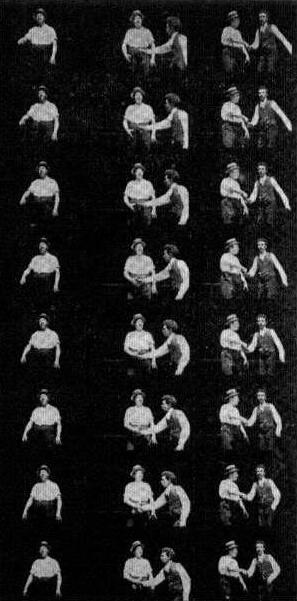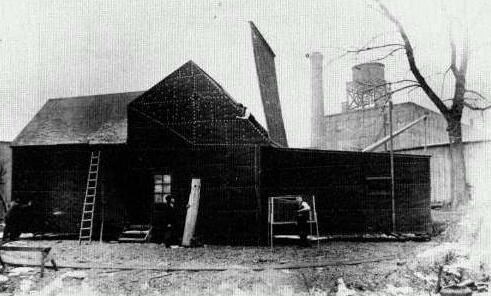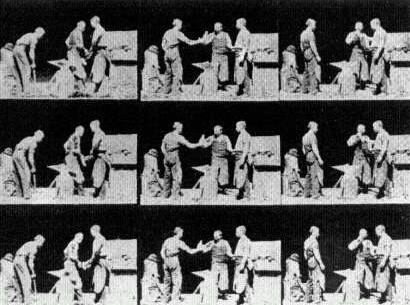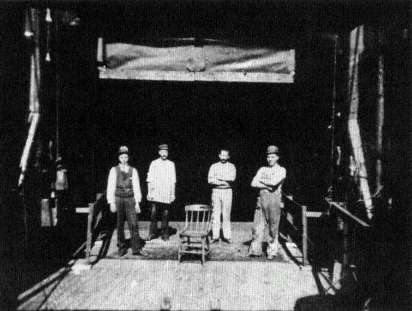Preparations
Construction of a motion picture studio began at Edison's West Orange laboratory in December 1892. The inventor and his secretary, Alfred O. Tate, were making commercial arrangements for the invention's exploitation at the World's Columbian Exposition in Chicago and production facilities were essential. The studio, which became known as the Black Maria, after the black paddy wagons it was said to resemble, was completed the following February at a cost of $637.67.[11] It was approximately fifty feet long and thirteen feet wide. A stage was at one end "entirely lined with black tar paper, giving the effect of a dead black tunnel behind the subject being photographed."[12] The studio rotated on a graphite center and tracks so that sunlight could fall directly on the performers.
The shift from experimental to commercial filmmaking involved many continuities. Blacksmith Scene , one of the first motion pictures shot in the new studio, illustrates this. The earliest Edison film to have a commercial life, it was taken before May 1893 by Dickson and Heise. As this suggests, the people immediately responsible for inventing the hardware remained in charge of the kinetograph during this new phase. Characteristically, Edison declined to shift personnel when moving from the phase of invention to that of commercial exploitation. Moreover, the collaborative approach to invention (i.e., Edison-
A Hand-Shake (1892). Dickson and Heise
congratulate each other on their invention.
The Black Maria studio (March 1894).
Dickson and Dickson-Heise) was continued as part of the production process. Other continuities are likewise striking: the black backgrounds and the frontal organizations of the mise-en-scène.
Blacksmith Scene depicted a blacksmith and his two helpers hammering an iron forging on the anvil, stopping to pass around a bottle of beer, and then resuming their labors. Although it reworked a subject previously photographed by Muybridge, the activity had become much more elaborate. Edison personnel constructed a fictional workspace within their workspace. Charles Kayser appears to be playing the role of the blacksmith, and the two others are almost certainly Edison employees. The world of the laboratory was transfigured in the blacksmith's shop. A conscious element of play was undoubtedly operating, for the crude smithy contrasted markedly with Edison's sophisticated machine shop. Yet there seem to have been important parallels. The fictionalized workspace has someone "in charge," the head blacksmith; but lines of authority are attenuated by egalitarianism and informality. Work, pleasure, and socializing are interwoven. In terms of American work culture, this scene already presents a nostalgic view, for, as Roy Rosenzweig has remarked, by the late nineteenth century, work and socializing were increasingly separated, with workplace drinking considered part of a bygone era.[13] Nevertheless, this film conveys the interpenetration of work and leisure characteristic of the Edison laboratory environment. The very making of the film seems to have been such an effort. Employees put aside serious undertakings to assume the roles of blacksmiths. If they were expected to work long hours and produce results, discipline was lax
Blacksmith Scene (1893). Work and pleasure are intermixed.
and responsibilities were often loosely defined. The informal lines of authority are also evident in the way that W. K. L. Dickson, the man most responsible for the film, copyrighted the subject even though the films and materials were owned by Edison.[14] Edison was not seeking to conduct an efficient workplace but to establish an environment where creativity could flourish.
Blacksmith Scene served as the centerpiece for the first public demonstration of Edison's new l½-inch system, at the Brooklyn Institute on May 9, 1893 (see document no. 1). Conducted by George M. Hopkins, president of the institute's Department of Physics, this presentation was remarkable in that it took the form of an illustrated lecture. To explain the principles on which the kinetograph and kinetoscope were based, Hopkins used a magic lantern to project a series of images from a choreutoscope (created in 1866), which created a dancing skeleton. Projected moving images from an instrument similar to Muybridge's zoöpraxiscope were also shown. Edison and Dickson's accomplishments were carefully situated in the general context of efforts being made in "chronophotography." The superior results of their efforts were carefully noted.
Selected frames of Blacksmith Scene were then projected onto the screen one frame at a time for inspection by the audience of approximately four hundred scientific people. Hopkins emphasized that the kinetoscope in its complete form was a machine for projecting images on the screen with recorded synchronous
The interior stage area of the Black Maria. Some
of the personnel appeared in Blacksmith Scene.
sound. Journal formats aside, the first public presentation of modern motion picture frames was done on this screen. Only at the evening's conclusion did those present file by a peep-hole kinetoscope and peer into the machine. With each peep taking half a minute, the last part of the evening lasted more than three hours.
DOCUMENT NO . 1 |
First Public Exhibition of Edison's Kinetograph. |
At the regular monthly meeting of the Department of Physics of the Brooklyn Institute, May 9, the members were enabled, through the courtesy of Mr. Edison, to examine the new instrument known as the kinetograph [sic , i.e., kinetoscope]. The instrument in its complete form consists of an optical lantern, a mechanical device by which a moving image is projected on the screen simultaneously with the production by a phonograph of the words or song which accompany the movements pictured. For example, the photograph of a prima donna would be shown on the screen, with the movements of the lips, the head, and the body, to- |
(Text box continued on next page)
gether with the changes of facial expression, while the phonograph would produce the song; but to arrange this apparatus for exhibition for a single evening was impracticable. Therefore, a small instrument designed for individual observation, and which simply shows the movements without the accompanying words, was shown to the members and their friends who were present. |
Mr. George M. Hopkins, president of the department, before proceeding to the exhibition of the instrument offered a brief explanation, in which he said: "This apparatus is the refinement of Plateau's phenakistoscope or the zootrope, and like everything Mr. Edison undertakes, it is carried to great perfection. The principle can be readily understood by anyone who has ever examined the instrument I have mentioned. Persistence of vision is depended upon to blend the successive images into one continuous ever-changing photographic picture. |
"In addition to Plateau's experiments, I might refer to the work accomplished by Muybridge and Anschuetz, who very successfully photographed animals in motion, and to Demeny, who produced an instrument called the phonoscope, which gave the facial expression while words were being spoken, so that deaf and dumb people could readily understand. But these instruments, having but twenty-five or thirty pictures for each subject, could not be made to blend the different movements sufficiently to make the image appear like a continuous photograph of moving things; the change from one picture to the next was abrupt and not realistic. In Mr. Edison's machine far more perfect results are secured. The fundamental feature in his experiments is the camera, by means of which the pictures are taken. This camera starts, moves, and stops the sensitive strip which receives the photographic image forty-six times a second, and the exposure of the plate takes place in one-eighth [sic ] of this time or in about one fifty-seventh of a second. The lens for producing these pictures was made to order at an enormous expense, and every detail at this end of the experiment was carefully looked after. There are 700 impressions on each strip, and when these pictures are shown in succession in the kinetograph the light is intercepted 700 times during one revolution of the strip. The duration of each image is one-ninety-second of a second, and the entire strip passes through the instrument in about thirty seconds. In the kinetograph each image dwells upon the retina until it is replaced by the succeeding one, and the difference between any picture and the succeeding one or preceding one is so slight as to render it impossible to observe the intermittent character of the picture. To explain in a very imperfect way the manner in which the photographs are produced, I will present the familiar dancing skeleton on the screen. You will notice that the image appears to be continuous, but the eye fails to notice the cutting |
(Text box continued on next page)
off of the light, and the image simply appears to change its position without being at all intermittent; but when the instrument is turned slowly, you will notice that the period of eclipse is much longer than the period of illumination. The photographs on the kinetograph strip were taken in some such way as this. I will exhibit an ordinary zootrope adapted to the lantern, which shows the principle of the kinetograph. In this instrument, a disk having a radial slit is revolved rapidly in front of a disk bearing a series of images in different positions, which are arranged radially. The relative speeds of these disks are such that when they are revolved in the lantern the radial slit causes the images to be seen in regular succession, so that they replace each other and appear to really be in motion; but this instrument, as compared with the kinetograph, is a very crude affair." |
After projecting upon the screen a few sections of the kinetograph strip, the audience—which consisted of more than 400 scientific people— was allowed to pass by the instrument, each person taking a view of the moving picture, which averaged for each person about half a minute. The picture represented a blacksmith and two helpers forging a piece of iron. Before beginning the job a bottle was passed from one to the other, each imbibing his portion. The blacksmith then removed his white hot iron from the forge with a pair of tongs and gave directions to his helpers with the small hand hammer, when they immediately began to pound the hot iron while the sparks flew in all directions, the blacksmith at the same time making intermediate strokes with his hand hammer. At a signal from the smith, the helpers put down their sledge hammers, when the iron was returned to the forge and another piece substituted for it, and the operation was repeated. |
In the picture exhibited in the kinetograph, every movement appeared perfectly smooth and natural, without any of the jerkiness seen in instruments of the zootrope type which have heretofore been exhibited. |
The machine in this case was not accompanied by the phonograph, but nevertheless the exhibition was one of great interest. The kinetograph in this form is designed as a "nickel in the slot" machine, and a number of them have been made for use at the Columbian Exhibition at Chicago. |
SOURCE : Scientific American , May 20, 1893, p. 310. |
The Black Maria was rarely used for production during 1893, as the refinement of Edison's motion picture system and the manufacture of kinetoscopes experienced delays. W. K. L. Dickson suffered from nervous exhaustion and was absent from the laboratory between early February and late April 1893. Although this accounts for some of the slowdown, the recession of 1893 may have further impeded this project, as Edison devoted his hard-pressed finances and time to iron ore milling. A new model kinetoscope for films taken with the
vertical-feed kinetograph was probably not available until shortly before the Brooklyn Institute demonstration in May. A contract for the manufacture of twenty-five machines based on this prototype was only drawn in late June. Gordon Hendricks indicates that it was given to an Edison employee who had difficulty staying sober. As a result, the machines were not completed until March 1894. Only the prototype was available for exhibition at the Chicago exposition, and this proved too valuable to send.[15]



